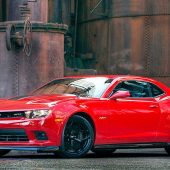The heart and soul of the 2013 SRT Viper is a hand-assembled 8.4-litre all-aluminum, V10 engine. For 2013, the engine features a new ultra-high-flow, composite intake manifold for improved air distribution, new forged pistons, new lightweight, sodium-cooled exhaust valves and an aluminum flywheel. The engine also includes new exhaust catalysts to reduce backpressure. The result is a significant improvement of 40 lb.-ft. of torque and 40 horsepower with weight savings of more than 25 pounds for the fully dressed engine. Preliminary performance ratings for the SRT-engineered V-10 include horsepower increased to 640 and torque increased to 600 lb.-ft., making it the highest torque of any naturally aspirated automotive engine in the world. Maximum engine speed (redline) is 6,200 rpm with fuel cutoff at 6,400 rpm.
Constructed of precision cast aluminum, the 90-degree, deep skirt block includes use of high-strength T356 aluminum and includes cast-iron bore liners, strengthened bulkheads that ensure block rigidity under high rpm operating condition and improved water jackets for consistent temperatures across the engine. Bore and stroke of the cylinders is 103 mm by 100.6 mm. The forged-steel crankshaft is supported by six main journals with cross-bolted, four-bolt, main-bearing caps, two vertical and two horizontal, for increased structural strength. Forged, powder -metal connecting rods measuring 158.6 mm are included for superior strength.
The new V10 includes the use of forged-aluminum pistons. In addition to higher strength, the new pistons are 10 grams lighter than the previous design to help reduce mass in the reciprocating assembly. Reduced diameter, full-floating, 24 mm piston pins also are new. In addition to forging, the pistons have been developed for reduced friction. New steel piston rings also reduce friction with a 1.5 mm top and a 1.2 mm second ring width. Compression ratio of the engine is 10.2:1.
One of the biggest contributors to the reduced rotating inertia in the powertrain is the aluminum flywheel. The new aluminum flywheel has reduced weight by 11 pounds. The flywheel includes a steel outer-ring gear and friction wear surface for durability. The flywheel, when combined with a twin plate 240 mm twin-disc clutch, reduces overall rotating inertia by 20 percent, translating in roughly 1/10th of a second reduction in 0-to-60 acceleration and improved performance in lap times on a typical road course by approximately .5 seconds.
The intake assembly of the 8.4-litre Viper V10 is entirely new with the adaptation of a new, lightweight composite intake manifold that provides better fuel/air distribution, excellent thermal capabilities and reduced weight. The new intake system features runners that are approximately one-inch longer than the previous design, and the move to a composite construction from aluminum has reduced air charge temperatures significantly. For 2013, new, electronically controlled twin throttles dramatically improve throttle response and control.
Like the block, cylinder heads are constructed of high-strength, T356 aluminum for superior strength. The combustion chambers have been computer numerical control (CNC) machined for improved flow and charge motion. Structural changes in the cylinder heads have been incorporated for strength and durability. Intake and exhaust valves are both angled at 12 degrees. Lightweight, hollow-stem, intake valves measuring 52.8 mm provide ample intake charging. Sodium-filled exhaust valves, measuring 40.8 mm, are now used. The use of lightweight valves helps reduce reciprocating mass from the valve train. Sodium is added to the exhaust valve stem for better heat transfer and helps prevent hot spots in the valve head and combustion chamber that can lead to engine knock.
Valves are actuated by a single assembled camshaft in the block. The Viper engine uses a unique roller-type cam-in-cam design that enables independent exhaust phasing relative to the intake. The intake profile has been revised to provide more usable torque at the higher rpm ranges of the engine. The V10 is equipped with variable-valve timing (VVT) on the exhaust side.
Tremec TR6060 six-speed transmission
The proven Tremec TR6060 six-speed manual transmission features an entirely new gear set for 2013 to provide the optimal transfer of power from the engine to the rear wheels. The new close-ratio gearing provides a smaller drop in between gear shifts, smoother gear synchronization and overall shift feel. The new gear set also takes full advantage with a more useful sixth gear that is designed for more power at the higher rpm ranges of the engine.
Drivers will feel a notable improvement in shifting quality with shift throws that are nearly 12.5 percent shorter due to a revised shifter-to-transmission connection. The leather-wrapped shifter assembly is connected directly into the transmission to eliminate complicated levers and pivots that interfere with communication with the driver. The result is a direct-mount shift system that provides a solid and precise shift feel. The SRT Viper will be equipped with a final-drive ratio of 3.55 to complement the tighter ratios that improve acceleration and responsiveness.
For 2013, all Viper models will feature traction control. To help maximize traction for straight-line performance, all Viper models also will include launch control as standard equipment. Also making its debut on Viper is an advanced multi-mode electronic stability control system. This feature will dramatically broaden the Viper’s performance envelope for drivers at all skill levels.









